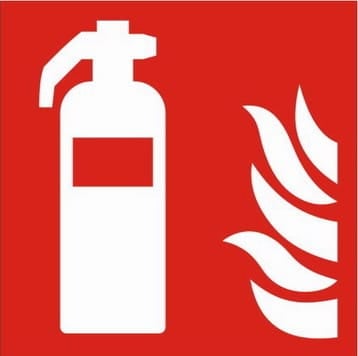It’s the National Fire Protection Association’s Fire Prevention Week, and their focus for the third year in a row is on smoke alarm safety. Smoke alarms are a great way to protect your family, pets, and home from unnecessary fire and smoke damage. We wrote about how to maintain them in a previous post.
But another safety measure you can — and should — take is to strategically locate fire extinguishers in your home. You can’t always prevent a fire, but you may be able to put it out quickly with a working fire extinguisher and an understanding of how to use it.
What Kind of Fire Extinguisher do I Need?
You can buy a fire extinguisher for as low as twenty bucks at a local hardware store, but which one should you buy? Look at the label, which will tell you:
- The type of fire it should be used on. All householder extinguishers are classified as A, B, or C (or a combination of these), indicating the types of fires they are effective against. A type A fire is fueled by ordinary combustibles, like wood, paper, and cloth. A type B fire is fueled by flammable liquids. And a type C fire is electrical in nature. Many extinguishers are effective on type A, B, and C fires.
- Its effectiveness against that type of fire. For type A and B extinguishers, the letters on the label are preceded by a number representing a rating assigned by Underwriters Laboratories that indicates the extinguisher’s effectiveness on type A and B fires. So, for example, a 4-A rating means a device is more effective on ordinary combustibles than one with a 2-A rating. The C classification doesn’t have an associated rating: It just means the extinguisher’s chemicals won’t conduct electricity, so it is appropriate for use on electrical fires.
- Its size. Fire extinguishers range in size from 2 to 10 pounds. A 2-pound extinguisher is best for cars. A 5-pound extinguisher is best for the kitchen or laundry room. And a 10-pound extinguisher is best for the garage or home workshop, where a fire might grow in size before getting noticed.
Can you PASS a Fire Extinguisher Test?
As the saying goes: “A fool with a tool is still a fool.” You and other family members need to learn how to operate a fire extinguisher to optimize its effectiveness. Remember this acronym: P – A – S – S.
- Pull the pin at the top of the extinguisher. This releases a locking mechanism, allowing you to discharge the extinguisher.
- Aim at the base of the fire, not the flames. This is critical: To put out a fire, you must extinguish its fuel source. Operate the extinguisher from a safe distance (at least 6 feet away or as directed on the extinguisher’s instructions) and then move toward the fire once it starts to diminish.
- Squeeze the lever slowly, keeping the extinguisher upright. This releases the extinguishing agent. (If the handle is released, the discharge will stop.)
- Sweep from side to side, moving the fire extinguisher back and forth until the fire is extinguished. Don’t walk away, however, when you think it is out, as it may re-ignite. Pay attention and keep your escape options open.
Where Do I Put My Fire Extinguishers?
Experts recommend that you install fire extinguishers where they are easily accessible, including at least one on each floor and one in the kitchen, garage, work room, and laundry room. Bathrooms are another high-risk area, as personal devices are prone to electrical shorts which can start a fire.
Additionally, placing them along your fire escape routes may give you the extra time you and your family need to escape to safety.
A Few More Fire Extinguisher Tips
In addition to the “Pull – Aim – Squeeze – Sweep” technique, experts recommend that you:
- Read the instructions that came with your fire extinguishers and familiarize yourself with their parts.
- Print the P – A – S – S acronym, and place it next to your fire extinguishers for easy reference.
- Check with your fire department to see if they offer hands-on training. Many do.
- Recharge your fire extinguisher after use. A typical extinguisher contains only 10 seconds of extinguishing power. Fire extinguisher companies charge about $15 to refill a typical 5-pound A:B:C extinguisher with a metal valve. (Those with plastic valves are not refillable and should be disposed of after use.
When available and charged, fire extinguishers can go a long way to protecting your family, pets, and possessions. Take some time to equip yourself with the protective capabilities of a fire extinguisher. And remember that life is more valuable than possessions, so don’t try to extinguish a fire by putting yourself or your family at risk. The Fire Equipment Manufacturer’s Association recommends that you only fight a fire if:
- The fire is small and contained.
- You are safe from toxic smoke.
- You have a means of escape.
- Your instincts tell you it’s OK.
If these criteria aren’t met, leave your home immediately and dial 9-1-1.
About Our Licensed Dallas Home Inspections
At Stonebriar Property Inspections, Dallas home inspector Keith Boggs proudly provides quality home inspections throughout North Texas seven days a week, including evenings and weekends. Contact him at (214) 923-7304 or [email protected].
- Licensed and insured – Texas Real Estate Commission license #9867. TDA licensed termite technician #0572333. PestGo Pest Control LLC TPCL #0770368
- Rated an A+ with the Dallas Better Business Bureau
- 5 out of 5 stars on 99% of customer reviews
- The most comprehensive home inspections available
- Friendly, down-to-earth service from someone you can trust


